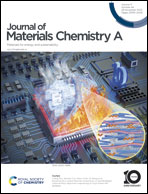Flexible nanocellulose-based layered films by crosslinking phosphorus lignin nanoparticles and functionalized boron nitride nanosheets for flame-resistant and thermal conductivity applications†
Abstract
The fast growth of micro-flexible electronic devices has increased the amount of heat generated and electronic waste, which has increased the demand for eco-friendly nanocellulose-based composites with great flame resistance and strong thermal conductivity. Nevertheless, creating appropriate thermally conductive fillers and enhancing the flame retardancy of materials based on nanocellulose remain extremely difficult tasks. This study describes the production of extremely in-plane oriented composite films using TEMPO-oxidized nanocellulose (TOCNF) as the matrix, boron nitride nanosheets (50 wt% BNNS@PDA) as the filler for thermal conductivity, and a small number of phosphorus lignin nanoparticles (2 wt% PL) as an auxiliary filler. First, the orderly organization of thermally conductive fillers in the composite film may be achieved using one-step ball milling, stripping, and non-covalent modification of hexagonal boron nitride, offering an efficient thermal conductivity channel to raise thermal conductivity. After filling in PL (2 wt%), due to the highly compact oriented structure and rich flame-retardant functional groups, the thermal conductivity and flame-retardant properties of the composite film are improved at the same time. The final results demonstrate that the composite film exhibits a high thermal conductivity of 23.49 W mK−1. Compared with a pure nanocellulose film, the TOCNF/BNNS@PDA/PL composite film has a better flame retardant effect and thermal stability. In addition, the composite films show satisfactory flexibility and mechanical properties due to their tight structure and strong interfacial interactions. In conclusion, this work provides a feasible solution for the application of nanocellulose-based thermal conductivity and flame-retardant dual-function composites in thermal management applications for next-generation flexible electronic devices.



 Please wait while we load your content...
Please wait while we load your content...